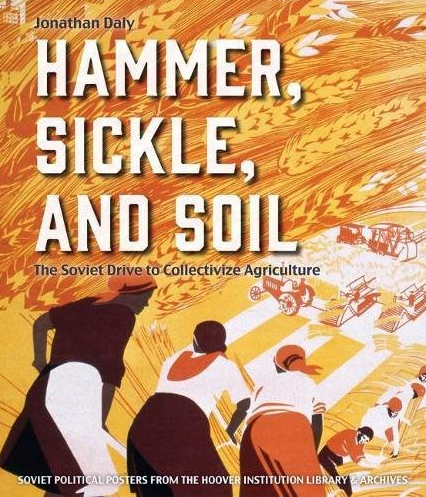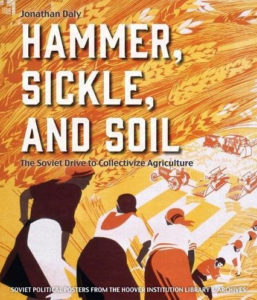

This book contains reproductions of more than sixty Soviet propaganda posters from the 1920s and 1930s, selected from a large collection at the Hoover Institution in Stanford, California. The posters are colorful and beautifully reproduced, but the book includes no information about the artists who made them, minimal information about their production and use, and little analysis of them. Instead, the text presents a concise history of Russia and the USSR that focuses on collectivization, dekulakization, and the 1931-1933 Soviet famine. The author, Jonathan Daly, a well-published historian at the University of Illinois at Chicago whose work has focused mainly on police forces and crime in Imperial Russia, presents this history in a readable narrative based on recent scholarship and published documents. Although he questions the widely-held view of the famine as a Ukrainian genocide, many of his interpretations are ideological rather than evidence-based, and omit important parts of the history. This review addresses only the most important of these.
Daly’s overall perspective derives in part from two general arguments found in most publications on collectivization and the famine. The “exploitation argument” holds that Soviet leaders harshly exploited the peasants to finance industrialization and create socialism, and rarely applied policies to benefit peasants. The “resistance argument” holds that the Soviet peasants were uniformly hostile to the Soviet regime, resisted its policies violently when they could and passively when they could not, were only concerned about their own income and were indifferent if not hostile to the urban population.[1] Both viewpoints are based on statements by Soviet officials and on western social science theories of the mid-twentieth century. Daly also employs an oversimplified and ahistorical economic assumption: “it is simply impossible to pay producers less than what the law of supply and demand requires and expect them to continue producing and delivering” (24).
The narrative consists of an introduction and four chapters. The introduction provides a brief historical background from Imperial Russia through the Soviet Civil War and the NEP period of the 1920s. Daly writes that Russia “always fell short of its geopolitical rivals in military power, commerce, technology, and industry” (1). Yet the Russians ultimately defeated all their geopolitical rivals. To begin where Daly did, from the reign of Peter the Great (1694-1725), the Russians defeated Swedish forces decisively in 1709 to become a major European power, defeated the Ottoman Turks repeatedly, taking over the Crimea and Black Sea littoral in the 1780s and defeating them in the Balkans in 1878, repulsed Napoleon’s invasion in 1812 and played the crucial role in defeating him in 1815, and overwhelmed Austrian forces in World War I. The only rivals Russia did not defeat in that period were Japan in 1905 and Germany in World War I, but the USSR defeated Japan at Nomonhan in 1939, and, together with the Allies, Nazi Germany in World War II.
The introduction then discusses the famine of 1891, Russian economic development, the Stolypin Land Reform, the disruption of World War I and the 1917 revolution, Bolshevik policies during the Russian Civil War, the 1921-1923 famine, and the early NEP period. The history he presents it is partly correct, but contains problematic passages. In one case, he writes, without any source or evidence, that “[D]uring the civil war [1918-1921], trading grain and other foodstuffs, instead of handing them over to the government at low fixed prices, became a crime punishable by death” (6). One law in February 1918 did allow the execution of private traders, called “bagmen,” but only if they put up armed resistance. By September 1918, the failure of such methods and the worsening crisis made the regime shift to a policy tolerating trade, and a new law authorized people to carry up to fifty pounds of food on the trains. While the Bolsheviks requisitioned food to feed the towns and their armies, free trade never stopped and supplied most of the food that reached the cities.[2] Daly does not mention either that the anti-communist White armies also requisitioned food from the peasants using harsh tactics.[3] Daly also asserts that the Bolsheviks provided little support to the victims of the 1921-1923 famine (6). Yet the Soviet government imported some 320,000 tons of food supplies in 1921 and 972,170 tons in 1922, and took measures to aid famine victims and help the peasant produce harvests in 1922 and 1923. Lenin also sent Nikolai Vavilov and other agronomists to the United States to obtain seed and other resources to improve Soviet farm production.[4]
Chapter 1, “Inching toward Armageddon,” describes the “grain crisis” of 1928-1929 and the leaders’ decision to implement collectivization and dekulakization. Daly narrates the regime’s coercive measures to obtain food supplies from villages, after the regime discovered in November 1928 that it had insufficient grain for the towns (24-25). He also discusses the beginning of the Five-Year Plan, measures to mechanize agriculture, repression against religion and the kulaks, and peasants’ responses to these developments. While this discussion is partly correct, Daly again resorts to ideological views, against his own evidence. He cites a report that peasants in 1929 responded to high procurements by planting “at least ten percent less” and adds: “Why plant if one’s crops will be taken?” (36) Yet later he writes that the USSR had a good harvest in 1930 due to a “high number of individual households planting in 1929” (60-61).
Daly’s discussion in this and the previous chapter also omits important policies. In 1924, after a serious crop failure, the Soviet government established a famine relief commission, imported several hundred thousand tons of food, and fed several million people until the larger 1925 harvest. In 1928, after crop failures in Ukraine, the government again set up a famine relief commission, transferred food from Russia to Ukraine, and fed hundreds of thousands of Ukrainians.[5] Portraying Soviet policies as only “taking” from the peasants is incomplete and makes them appear more uniformly repressive and anti-peasant than they were, since some of those procurements went to feed peasants in famine regions.
The second chapter, “Apocalypse Now, 1930-1931,” interweaves the histories of collectivization, dekulakization, and the formation of the Gulag and the Special Settlements, which contained at first mostly dekulakized peasants. Daly presents examples of the violence and irrationality that accompanied the collectivization and dekulakization campaigns of winter 1930 and much of 1931. He also cites the accurate data from recent studies on the number of people arrested, exiled, and killed, numbers much smaller than the estimates in older literature.[6] Daly, adhering to the “resistance argument,” exaggerates peasant resistance to collectivization, describing it as a “wall of solidarity” in the villages (115). He cites the now well-known figure of 13,754 peasant protests in early 1930 that included 3.3 million peasants (49), but he does not compare this to his earlier passage that the USSR had 130 million peasants (45). How much solidarity was there if fewer than five percent of peasants protested?[7] He also notes that Stalin’s article “Dizzy with Success,” which blamed abuses during collectivization on local officials, “seems to have aroused more than quieted the peasants” (51), a point I made in an earlier publication.[8] Historically, Russian peasants protested when they thought the authorities were divided or when they thought they had official support in a dispute.[9] This implies that Stalin’s article might have provoked the peasants’ protests.
On dekulakization, Daly emphasizes that very few peasants could be categorized as “kulaks,” since all seemed equally poor. Yet he asserts that dekulakization removed from the village the “competent and hard-working farmers” (81, 115). If peasants were so uniformly poor, how could there have been such a clear distinction between the hard-working ones and those who did not work hard? The Soviet economist Alexander Chaianov argued in the 1920s, based on long-term studies, that peasant society had a pattern of cyclic mobility and that peasant families changed their status with changing family size and age. This suggests that it is impossible, and unfair to the peasants, to conclude that the peasants dekulakized were the only hard-working ones.[10] Daly never explains that the concept of “kulak” as an exploiter of peasants, and peasant hostility to them, long predates the Soviet regime.[11]
The third chapter, “Demographic Catastrophe, 1932-1933,” narrates the course of the peak of the famine and its decline, describing along the way conditions in the penal system and the cities, the regime’s repressive actions against peasants and others who took grain from fields and storage, and addressing briefly the issue of the famine as genocide. Unlike several previous works, Daly recognizes that the USSR had low harvests in 1931 and 1932. Yet he almost completely overlooks their environmental causes. Daly attributes the low 1931 harvest to a “failing work ethic. Since people were not being paid adequately for their work, they got into the habit of not working adequately. They planted less, failed to weed their fields, harvested without enthusiasm, and delivered crops negligently” (65). Yet Soviet peasants did not earn wages, they worked for the harvest, like peasants had for centuries: they were paid in “labordays” but these were paid in kind after the harvest. In 1931 they planted more than in any previous year, 104 million hectares, and grain procurements were also larger in that year than before, over 22 million tons.[12] Most important, a serious drought in 1931 drastically reduced harvests. The government held a public scientific conference on drought and how to fight it.[13]
In discussing the crucial 1932 harvest, Daly mentions that “wheat rust and other disease struck the crops” (73) without citing any source or explaining their effects. In fact, plant diseases reduced the 1932 grain harvest by about nine million tons, and other infestations also cut into the harvest.[14] Daly notes that the 1932 grain harvest “may have been as low as 55 million tons” (73). Yet later he writes that the grain procurements in 1932 took roughly 40 percent of the entire harvest (83). Since procurements in 1932 were about 18 million tons, this implies a harvest of 45 million tons. Without addressing this inconsistency or the effects of the environment on the harvest, Daly asserts again that the low harvest of 1932 was the result of peasant resistance (81).
While Daly repeatedly invokes his economic assumptions to claim peasants worked less (which as noted above much evidence contradicts), he does not document the scale of this resistance. He also does not explain why peasants would risk their family’s or their village’s subsistence by working poorly, nor why peasants who lived through harsh procurement campaigns from 1928 could think that if they cut back their production, the regime would not procure from them anyway. He interprets Soviet officials’ statements during 1933 applauding peasants’ hard work to mean that the famine “broke the resistance” of the peasants (85, 88, 93). Yet the data on the plant diseases did not reach top leaders, who (as noted above) did recognize the 1931 drought.[15] Ignorant of the environmental factors, leaders jumped to the conclusions that Daly cites, and misunderstood both the famine’s causes and the peasants’ attitudes.
Daly justifies the peasants’ alleged efforts to reduce food production as a rational and normal economic response without considering that such actions would have threatened the survival of millions of people in the towns, including many from the peasants’ own villages. He views peasants’ hard work in 1933 as the result of the regime’s destruction of their age-old will to resist (93), but never considers that the harvest they produced saved the lives of millions of people both within and outside the villages. He also documents that millions of peasants went to towns or were exiled, but he never considers the possibility that the peasants who remained might have understood that their work helped feed their relatives and former neighbors. Other sources show that many peasants worked hard in 1932 and displayed the “resistant” behavior Daly cites for 1932 in 1933.[16]
Chapter four, “A Broken People, 1934-“ [sic], discusses the recovery from the famine and the impact of the Great Terror on rural people, and in particular the role of the peasants’ private plots, which they were authorized to have in the model statute of March 1930 during the first collectivization campaign (and not in December 1933 (134) as Daly claims).[17] Daly argues that peasants devoted the “lion’s share” of their time to the private plot (99, 101), and discusses regime policies to require peasants to work in the collectives. The main problem in the collective farms, pace Daly and other advocates of the resistance argument, was not peasant resistance but peasant unemployment.[18] One goal of collectivization was to free labor for industry, but industry could absorb only part of that labor. Soviet investigations in the 1930s showed that collective farms could do all their work employing only about half of the people living in them.[19] Many peasants focused on their private plots because there was little other work for them in the collective farms, a reality that Soviet leaders, so suspicious of the peasants, did not understand until after Stalin.
The “Conclusion” reviews his arguments, discusses the long-term effects of the famine on peasants, agriculture, and the Soviet system, and returns to the issue of genocide. Daly asserts that peasants in collectives had to follow central instructions and “gradually forgot how to be peasants” and how to farm with individual initiative (115). Yet in other passages he emphasizes how hard peasants worked in their small “private plot” farms, on their own initiative, and how large a share of Soviet food they produced and sold in private-sector markets (103ff, 115). He repeatedly emphasizes that Soviet livestock numbers did not reach the levels of 1928 until 1958 (75, 91), but he never mentions the enormous livestock losses in World War II that delayed this recovery. He also does not mention that cattle numbers in Russia fell from 17 million in 1988, under Communism, to 6.4 million in 2017, under the free market economy of post-Soviet Russia.[20] He also blames collectivization for the departures of young and skilled people from rural areas, with the remaining population becoming older, depressed, and alcoholic (128). Yet these and worse problems have long affected rural areas in America and many other countries.[21] This pattern is a result of modernization, of which collectivization was an example.[22]
Daly also argued that Soviet policies made the USSR into a massive importer of food in the post-Stalin period (115, 128). In fact, Soviet food production increased in the decades after World War II, and in the post-Stalin period the USSR became a major world producer of wheat and other crops. The Soviets produced more wheat even in the three worst crop failure years under Khrushchev and Brezhnev (46 million tons in 1963, 79.6 million tons in 1972, 61.8 million tons in 1975) than the United States in those years (31 million tons in 1963, 42 million tons in 1972, and 57.9 million tons in 1975), and much more wheat that the United States in most other years.[23] This improved output resulted in part from Soviet development of high-yielding semi-dwarf wheat varieties, a “Green Revolution” independent of the United States led by the Soviet breeder Pavel Luk’ianenko.[24] The imports went mostly to feed the Soviets’ large livestock herd, the enlargement of which was the result of regime policies for decades after collectivization.
Daly twice discusses whether the 1931-1933 famine was genocide, both times questioning the claims of a Ukrainian genocide because the famine was not limited to Ukraine and may have been worse in Kazakhstan and some parts of the Volga (88, 121). But in these discussions, he notes that the regime in 1933 “sent modest food aid” to famine regions, mostly in the second half of the year (88). In fact, the regime sent 5.6 million tons of grain back to the villages during the first half of 1933, from its limited grain reserves and 1932 grain procurements. These were one of the reasons why the urban population suffered so much during the famine.[25] He also argues that Ukraine was a threat to the Soviet regime because it had a larger rural population — 24 million — than the Russian republic — 22 million. In fact, the rural population of Russia was 76.6 million, more than triple that of Ukraine (121).[26]
Hammer, Sickle, and Soil is comprehensive and accurate in some parts, but unfortunately its many inaccuracies, omissions, and distortions create a one-sided and misleading impression of Soviet agrarian history. Perhaps the main problem with Daly’s interpretation is his assumption that “the law of supply and demand” makes it “impossible” to pay people too little and then expect them to work hard. History and the present are full of cases of people who were very productive despite receiving “inadequate” pay or even no pay. To cite just one of many examples, American farm workers from the Dust Bowl, Asia, and Central America were routinely paid below-subsistence wages, sometimes no wages for certain periods, and were victimized or fired if they complained, yet produced vast amounts of crops and livestock.[27] Historians should be wary of relying on social science theories, especially simplistic ones.
Reviewed by Mark B. Tauger, West Virginia University
Hammer Sickle, and Soil: The Soviet Drive to Collectivize Agriculture
by Jonathan Daly
Publisher: Hoover Institution Press
Hardcover / 176 pages / 2017
ISBN: 978-0-8179-2064-7
[1] I have discussed these arguments and presented evidence contradicting them in “Stalin, Soviet Agriculture, and Collectivization,” in Food and Conflict in Europe in the Age of the Two World Wars, ed. Frank Trentmann and Fleming Just, New York: Palgrave Macmillan, 2006, 109-142; and “Soviet Peasants and Collectivization, 1930-1939: Resistance and Adaptation,” in Stephen Wegren, ed., Rural Adaptation in Russia, New York: Routledge, 2005, 65-94.
[2] See for example E. H. Carr, The Bolshevik Revolution, London: MacMillan, 1952, pp. 119, 240ff.
[3] See for example Peter Kenez, Civil War in South Russia, 2 vols, Berkeley: University of California Press, 1971-1972.
[4] See Statischeskii ezhegodnik 1922-1923 gg., Moscow, 1924, p. 250; M. Ia. Kaufman, Vneshniaia torgovlia Rossii (1918-1921 gg.), Petrograd, 1922, p.43; V.D. Esakov, Nikolai Ivanovich Vavilov: Stranitsy biografii, Moscow: Nauka, 2008, pp. 132ff.
[5] See Tauger,”La famine soviétique “inconnue” de 1924-1925,” in Famine et Transformation Agricole en URSS, Editions Delga, Paris, 2017, 27-75. ; and “Grain Crisis or Famine? The Ukrainian State Commission for Aid to Crop Failure Victims and the Ukrainian Famine of 1928-1929,” in D. J. Raleigh, ed., Provincial Landscapes: Local Dimensions of Soviet Power (Pittsburgh: University of Pittsburgh Press, 2001), 146-170. Both of these famines and famine relief measures are documented not only in archives but in the Soviet and Western press.
[6] For example, the late Robert Conquest, the Hoover Institution’s former Soviet specialist, claimed that 6.5 million people died as a result of dekulakization; Harvest of Sorrow, New York: Oxford University Press, 1986, 306. Daly, based on recent archival publications, shows that the total number of people dekulakized did not reach that number, and that during the most violent part dekulakization campaign, in 1930, “secret police” executed 18,966 kulaks (54), which is criminal and a tragedy, but not 6.5 million. Daly notes again from recent research that many people died in the labor camps and special settlements, but it was not anywhere near millions of people.
f[7] “Soviet Peasants and Collectivization,” 71.
[8] “Soviet Peasants and collectivization,” 74-75.
[9] David Moon, The Russian Peasantry, Longman, 1999, pp. 264-5; Daniel Field, Rebels in the Name of the Tsar, Houghton-Mifflen, 1976.
[10] See Teodor Shanin, The Awkward Class, Oxford: Clarendon, 1972, and my discussion of this in Natural Disaster and Human Actions in the Soviet Famine of 1931-1933, The Carl Beck Papers in Russian & East European Studies (Pittsburgh: REES, University of Pittsburgh, 2001), no. 1506.
[11] See for example the discussion of kulachestvo by the Tsarist Minister of Agriculture A. S. Ermolov, Nashi neurozhie i narodnoe bedstvie, St Petersburg, 1892, pp. 179-190.
[12] On sowings, Tauger, “The 1932 Harvest and the Famine of 1933.” Slavic Review, v. 50 no. 1, Spring 1991,72. Daly never cites the actual grain procurements for the famine years 1932-1933. For 1930 and 1931 he cites the figures 48.4 million and 51.8 million centners (4.84 & 5.18 million tons, 65) which were the annual grain exports and not procurements. Procurements for 1930 and 1931 were 22 and 22. 8 million tons; Tauger, “1932 Harvest,” 72.
[13] Tauger, Natural Disaster and Human Actions in the Soviet Famine of 1931-1933, Carl Beck Papers in Russian and East European Studies no. 1506, Pittsburgh: University of Pittsburgh, 2001, p. 8ff; Tezisy i materialy vsesoiuznoi konferentsii po bo’be s zasukhoi, Moscow, 1931.
[14] This was one of the main points of my paper Natural Disaster and Human Actions, and of an early version presented in 1994 at the Yale Agrarian Studies Program. I also documented (as Daly argues in this book) that the famine caused hunger and deprivation widely in the USSR, in towns as well as villages (Tauger, “The 1932 Harvest…”). Daly does not cite either of these publications. According to the American Historical Association, “[P]lagiarism can also include the limited borrowing, without sufficient attribution, of another person’s distinctive and significant research finds or interpretations.” Statement on Standards of Professional Conduct, Washington, D.C.: American Historical Association, 2012, p. 9.
[15] Tauger, Natural Disaster, 40ff.
[16] See Tauger, “Soviet Peasants and Collectivization.”
[17] See Pravda, 2 March 1930, Svod Zakonov SSSR 1930 no. 24, p. 255, and other sources.
[18] I discussed these issues in my dissertation, Commune to Kolkhoz, Los Angeles: UCLA, 1991.
[19] Tauger, “Soviet Peasants and Collectivization,” 77-78.
[20] Again from USDA data published in Index Mundi: search Index Mundi Russia livestock.
[21] There is a large literature on this; some examples are Marion Clawson, “Aging Farmers and Agricultural Policy,” Journal of Farm Economics, v. 45 n. 1, February 1963, 13-30; Alana Semuels, “Can anything stop rural decline?” (on the aging rural population in Japan), The Atlantic, 23 August 2017; Paméla Rougerie, “Quiet Epidemic of Suicide Claims France’s Farmers,” New York Times, 20 August 2017.
[22] I have examined these types of comparisons in “Modernisation in Soviet Agriculture,” in Modernisation and Russian Society since 1900, ed. Markku Kangaspuro and Jeremy Smith, Helsinki: SKS (Suomalaisen Kirjallisuuden Seura ), 2006.
[23] My sources for these data are USDA data published online in Index Mundi: for some reason, when I copy the website, they both show up the same, but one can search: index mundi soviet wheat production and United States wheat production to obtain the tables.
[24] Tauger, “Pavel Pateleimonovich Luk’ianenko and the Origins of the Soviet Green Revolution,” in The Lysenko Controversy as a Global Phenomenon, v. 1: Genetics and Agriculture in the Soviet Union and Beyond, William deJong-Lambert & Nikolai Krementsov, eds., Palgrave, 2017.
[25] Tauger, “The 1932 Harvest,” Table 2, p. 74; Tauger, R. W. Davies, S. G. Wheatcroft, “Soviet Grain Stocks and the Famine of 1932-1933,” Slavic Review v. 54 no. 3, Fall 1995, 642-657.
[26] Vsesoiuznaia perepis’ naseleniia 1937 g. Kratkie itogi, Moscow: 1991, 48-51.
[27] See for example the statement by a Hispanic farm worker at a Senate hearing in 1969: http://historymatters.gmu.edu/d/7024 .
Published December 14, 2017.




